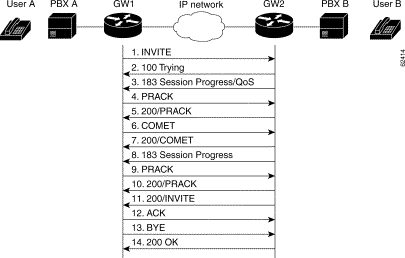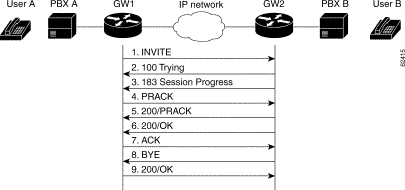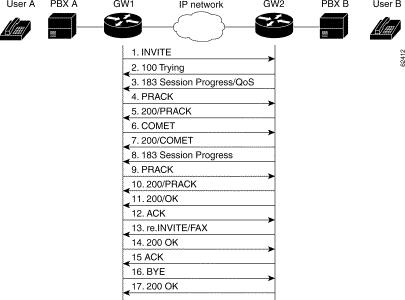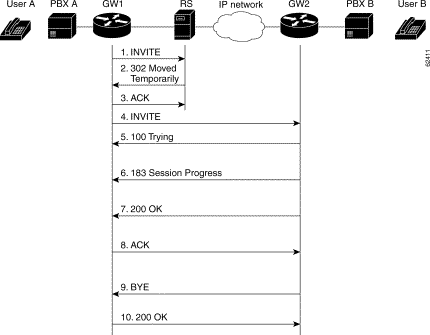SIP Call with RSVP QoS Output from GW1 Side
GW1 ---INVITE---> GW2 (F1)
GW1 <-100Trying-- GW2 (F2)
GW1 <--183/QoS--- GW2 (F3)
GW1 ---PRACK----> GW2 (F4)
GW1 <-200/PRACK-- GW2 (F5)
GW1 ---COMET----> GW2 (F6)
GW1 <-200/COMET-- GW2 (F7)
GW1 <-183SesProg- GW2 (F8)
GW1 ---PRACK----> GW2 (F9)
GW1 <-200/PRACK-- GW2 (F10)
GW1 <--200/INV--- GW2 (F11)
GW1 -----ACK----> GW2 (F12)
GW1 -----BYE----> GW2 (F13)
GW1 <---200OK---- GW2 (F14)
 |
Note The call-flows and messaging is per the IETF draft
'draft-ietf-sip-manyfolks-resource-02.txt'.They show the GW integrating the messaging for
SIP to use RSVP to signal the network for resources prior to a VoIP call being setup.
|
INVITE sip:36602@172.18.193.120;user=phone SIP/2.0
Via: SIP/2.0/UDP 172.18.193.98:5060
From: "36601"<sip:36601@172.18.193.98>;tag=136564-4EF
To: <sip:36602@172.18.193.120;user=phone>
Date: Mon, 01 Mar 1993 GMT
Call-ID: 7D5FB580-14F111CC-80109D18-7AB2874B@172.18.193.98
Cisco-Guid: 2083424384-351343052-2148441368-2058520395
User-Agent: Cisco-SIPGateway/IOS-12.x
Contact: <sip:36601@172.18.193.98:5060;user=phone>
Content-Type: application/sdp
o=CiscoSystemsSIP-GW-UserAgent 5800 3094 IN IP4 172.18.193.98
m=audio 17158 RTP/AVP 0 18
 |
Note INVITE sent with QoS required. This is signaled in the Supported: header.
|
Via: SIP/2.0/UDP 172.18.193.98:5060
From: "36601"<sip:36601@172.18.193.98>;tag=136564-4EF
To: <sip:36602@172.18.193.120;user=phone>;tag=12F5AC-268A
Date: Mon, 01 Mar 1993 00:20:42 GMT
Call-ID: 7D5FB580-14F111CC-80109D18-7AB2874B@172.18.193.98
Server: Cisco-SIPGateway/IOS-12.x
SIP/2.0 183 Session Progress
Via: SIP/2.0/UDP 172.18.193.98:5060
From: "36601"<sip:36601@172.18.193.98>;tag=136564-4EF
To: <sip:36602@172.18.193.120;user=phone>;tag=12F5AC-268A
Date: Mon, 01 Mar 1993 00:20:42 GMT
Call-ID: 7D5FB580-14F111CC-80109D18-7AB2874B@172.18.193.98
Server: Cisco-SIPGateway/IOS-12.x
Contact: <sip:36602@172.18.193.120:5060;user=phone>
Content-Type: application/sdp
Content-Disposition: precondition;handling=required
o=CiscoSystemsSIP-GW-UserAgent 1431 3084 IN IP4 172.18.193.120
a=qos:mandatory sendrecv confirm
 |
Note Response received with the QoS request acknowledged.
|
PRACK sip:36602@172.18.193.120:5060;user=phone SIP/2.0
Via: SIP/2.0/UDP 172.18.193.98:5060
From: "36601"<sip:36601@172.18.193.98>;tag=136564-4EF
To: <sip:36602@172.18.193.120;user=phone>;tag=12F5AC-268A
Date: Mon, 01 Mar 1993 GMT
Call-ID: 7D5FB580-14F111CC-80109D18-7AB2874B@172.18.193.98
 |
Note Acknowledgement of the QoS request is received.
|
Via: SIP/2.0/UDP 172.18.193.98:5060
From: "36601"<sip:36601@172.18.193.98>;tag=136564-4EF
To: <sip:36602@172.18.193.120;user=phone>;tag=12F5AC-268A
Date: Mon, 01 Mar 1993 00:20:42 GMT
Call-ID: 7D5FB580-14F111CC-80109D18-7AB2874B@172.18.193.98
Server: Cisco-SIPGateway/IOS-12.x
COMET sip:36602@172.18.193.120:5060;user=phone SIP/2.0
Via: SIP/2.0/UDP 172.18.193.98:5060
From: "36601"<sip:36601@172.18.193.98>;tag=136564-4EF
To: <sip:36602@172.18.193.120;user=phone>;tag=12F5AC-268A
Date: Mon, 01 Mar 1993 GMT
Call-ID: 7D5FB580-14F111CC-80109D18-7AB2874B@172.18.193.98
Content-Type: application/sdp
o=CiscoSystemsSIP-GW-UserAgent 5800 3094 IN IP4 172.18.193.98
m=audio 17158 RTP/AVP 0 18
 |
Note Bidirectional QoS is established. The RSVP signaling between the gateways and the IP
network has been completed as well.
|
Via: SIP/2.0/UDP 172.18.193.98:5060
From: "36601"<sip:36601@172.18.193.98>;tag=136564-4EF
To: <sip:36602@172.18.193.120;user=phone>;tag=12F5AC-268A
Date: Mon, 01 Mar 1993 00:20:42 GMT
Call-ID: 7D5FB580-14F111CC-80109D18-7AB2874B@172.18.193.98
Server: Cisco-SIPGateway/IOS-12.x
SIP/2.0 183 Session Progress
Via: SIP/2.0/UDP 172.18.193.98:5060
From: "36601"<sip:36601@172.18.193.98>;tag=136564-4EF
To: <sip:36602@172.18.193.120;user=phone>;tag=12F5AC-268A
Date: Mon, 01 Mar 1993 00:20:42 GMT
Call-ID: 7D5FB580-14F111CC-80109D18-7AB2874B@172.18.193.98
Server: Cisco-SIPGateway/IOS-12.x
Contact: <sip:36602@172.18.193.120:5060;user=phone>
Content-Type: application/sdp
Content-Disposition: session;handling=required
o=CiscoSystemsSIP-GW-UserAgent 1431 3084 IN IP4 172.18.193.120
PRACK sip:36602@172.18.193.120:5060;user=phone SIP/2.0
Via: SIP/2.0/UDP 172.18.193.98:5060
From: "36601"<sip:36601@172.18.193.98>;tag=136564-4EF
To: <sip:36602@172.18.193.120;user=phone>;tag=12F5AC-268A
Date: Mon, 01 Mar 1993 GMT
Call-ID: 7D5FB580-14F111CC-80109D18-7AB2874B@172.18.193.98
Via: SIP/2.0/UDP 172.18.193.98:5060
From: "36601"<sip:36601@172.18.193.98>;tag=136564-4EF
To: <sip:36602@172.18.193.120;user=phone>;tag=12F5AC-268A
Date: Mon, 01 Mar 1993 00:20:42 GMT
Call-ID: 7D5FB580-14F111CC-80109D18-7AB2874B@172.18.193.98
Server: Cisco-SIPGateway/IOS-12.x
Via: SIP/2.0/UDP 172.18.193.98:5060
From: "36601"<sip:36601@172.18.193.98>;tag=136564-4EF
To: <sip:36602@172.18.193.120;user=phone>;tag=12F5AC-268A
Date: Mon, 01 Mar 1993 00:20:42 GMT
Call-ID: 7D5FB580-14F111CC-80109D18-7AB2874B@172.18.193.98
Server: Cisco-SIPGateway/IOS-12.x
Contact: <sip:36602@172.18.193.120:5060;user=phone>
Content-Type: application/sdp
o=CiscoSystemsSIP-GW-UserAgent 1431 3084 IN IP4 172.18.193.120
ACK sip:36602@172.18.193.120:5060;user=phone SIP/2.0
Via: SIP/2.0/UDP 172.18.193.98:5060
From: "36601"<sip:36601@172.18.193.98>;tag=136564-4EF
To: <sip:36602@172.18.193.120;user=phone>;tag=12F5AC-268A
Date: Mon, 01 Mar 1993 GMT
Call-ID: 7D5FB580-14F111CC-80109D18-7AB2874B@172.18.193.98
BYE sip:36602@172.18.193.120:5060;user=phone SIP/2.0
Via: SIP/2.0/UDP 172.18.193.98:5060
From: "36601"<sip:36601@172.18.193.98>;tag=136564-4EF
To: <sip:36602@172.18.193.120;user=phone>;tag=12F5AC-268A
Date: Mon, 01 Mar 1993 GMT
Call-ID: 7D5FB580-14F111CC-80109D18-7AB2874B@172.18.193.98
User-Agent: Cisco-SIPGateway/IOS-12.x
Via: SIP/2.0/UDP 172.18.193.98:5060
From: "36601"<sip:36601@172.18.193.98>;tag=136564-4EF
To: <sip:36602@172.18.193.120;user=phone>;tag=12F5AC-268A
Date: Mon, 01 Mar 1993 00:21:22 GMT
Call-ID: 7D5FB580-14F111CC-80109D18-7AB2874B@172.18.193.98
Server: Cisco-SIPGateway/IOS-12.x
Figure C-2 SIP Call with RSVP QoS

Table C-2
| Step
|
Action
|
Description
|
F1
|
INVITE—SIP Gateway 1 to SIP Gateway 2
|
SIP gateway 1 sends an INVITE request to SIP gateway 2. The INVITE request is an invitation to User B to participate in a call session.
In the INVITE request:
The phone number of User B is inserted in the Request-URI field in the form of a SIP URL. The SIP URL identifies the address of User B and takes a form similar to an email address (user@host where user is the telephone number and host is either a domain name or a numeric network address). In this example, the Request-URI field in the INVITE request to User B appears as "36602@172.18.193.120;user=phone". The "user=phone" parameter distinguishes that the Request-URI address is a telephone number rather than a username.
- PBX A is identified as the call session initiator in the From field.
- A unique numeric identifier is assigned to the call and is inserted in the Call-ID field.
- The transaction number within a single call leg is identified in the CSeq field.
- The media capability (designated by m=) User A is ready to receive is specified. In this case m=audio 17158 RTP/AVP 0 18.
- The port on which SIP gateway 1 is prepared to receive the RTP data is specified.
|
F2
|
100 Trying—SIP Gateway 2 to SIP Gateway 1
|
SIP gateway 2 sends a 100 Trying response to the INVITE request sent by SIP gateway 1. The 100 Trying response indicates that the INVITE request has been received by SIP gateway 2 but that User B has not yet been located.
|
F3
|
183 Session Progress/QoS—SIP Gateway 2 to SIP Gateway 1
|
SIP gateway 2 sends a 183 Session Progress response to SIP gateway 1. The 183 Session Progress response indicates that SIP gateway 2 has located, and is trying to perform inband alerting for the caller.
Additionally Quality of Service (QoS) reserves sufficient network-layer resources to guarantee bandwidth and bounds on packet loss, delay, and jitter; thus ensuring that the called party's phone rings only after bandwidth required for the call has been successfully reserved.
|
F4
|
PRACK—SIP Gateway 1 to
SIP Gateway 2
|
SIP gateway 1 acknowledges the 183 Session Progress/QoS response with a PRovisional ACKnowledgement (PRACK).
|
F5
|
200/PRACK—SIP Gateway 2 to SIP Gateway 1
|
The 200 OK/PRovisional ACKnowledgement (PRACK) response notifies SIP gateway 1 that the connection has been made.
The SIP gateway generates this response when the PBX indicates that the connection has been made. On receiving this response, the gateway forwards the response to the corresponding party and responds with a PRACK.
|
F6
|
COMET—SIP Gateway 1 to
SIP Gateway 2
|
SIP gateway 1 sends a COnditions MET (COMET) response to SIP gateway 2 indicating that the preconditions have been met.
|
F7
|
200/COMET—SIP Gateway 2 to SIP Gateway 1
|
The 200 OK/COnditions MET (COMET) response notifies SIP gateway 1 that the conditions for the call have been met.
|
F8
|
183 Session Progress—
SIP Gateway 2 to SIP Gateway 1
|
The 183 Session Progress response is used to perform inband alerting for the caller.
|
F9
|
PRACK—SIP Gateway 1 to
SIP Gateway 2
|
SIP gateway 1 acknowledges the 183 Session Progress response with a PRovisional ACKnowledgement (PRACK).
|
F10
|
200/PRACK—SIP Gateway 2 to Gateway 1
|
The 200 OK/PRovisional ACKnowledgement (PRACK) response notifies SIP gateway 1 that the connection has been made.
The SIP gateway generates this response when the PBX indicates that the connection has been made. Upon receiving this response, the gateway forwards the response to the corresponding party and responds with a PRACK.
|
F11
|
200/INVITE—SIP Gateway 2 to SIP Gateway 1
|
The 200/INVITE response acknowledges that the connection has been made and SIP gateway 2 sends a new INVITE request to SIP gateway 1.
|
F12
|
ACK—SIP Gateway 1 to
SIP Gateway 2
|
SIP gateway 1 sends an ACK to SIP gateway 2. The ACK confirms that SIP gateway 1 has received the 200 OK response from SIP gateway 2.
|
F13
|
BYE—SIP Gateway 1 to
SIP Gateway 2
|
SIP gateway 1 sends a BYE request to SIP gateway 2. The BYE request indicates that User B wants to release the call. Because it is User B that wants to terminate the call, the Request-URI field is now replaced with PBX A's SIP URL and the From field contains User B's SIP URL.
|
F14
|
200 OK—SIP Gateway 2 to
SIP Gateway 1
|
SIP gateway 2 sends a 200 OK response to SIP gateway 1. The 200 OK response notifies SIP gateway 2 that SIP gateway 1 has received the BYE request.
|
SIP Call with RSVP QoS Output from GW1 Side
SIP Call Using RFC2833 for DTMF-Relay Output from GW1 Side
Call Trace with Different Payload Types:
In this trace both ends have been configured to use NTE dtmf relay mode. However the payload types for NTE packets have different values on both ends. The originator is configured to use value 115, terminator will use default value of 101. The payload value can be configured at the dial peer with
rtp payload-type nte 101command. Because 101 is default payload type and this value is not being used at the Originator for any other payload type, the two ends agree to use payload type 101.
GW1 ---INVITE---> GW2 (F1)
GW1 <-100Trying-- GW2 (F2)
GW1 <-183SesProg- GW2 (F3)
GW1 <---200OK---- GW2 (F4)
GW1 -----ACK----> GW2 (F5)
GW1 <----BYE----- GW2 (F6)
GW1 ---200OK----> GW2 (F7)
INVITE sip:36602@172.18.193.120:5060;user=phone SIP/2.0
Via: SIP/2.0/UDP 172.18.193.98:5060
From: "36601"<sip:36601@172.18.193.98>
To: <sip:36602@172.18.193.120;user=phone>
Date: Mon, 01 Mar 1993 00:23:13 GMT
Call-ID: C6310C75-14F111CC-801D9792-19DC655A@172.18.193.98
Cisco-Guid: 3301622965-351343052-2149291922-433874266
User-Agent: Cisco-SIPGateway/IOS-12.x
Contact: <sip:36601@172.18.193.98:5060;user=phone>
Content-Type: application/sdp
o=CiscoSystemsSIP-GW-UserAgent 6351 4261 IN IP4 172.18.193.98
m=audio 18720 RTP/AVP 18 101
a=rtpmap:101 telephone-event/8000
 |
Note The INVITE is sent, and it requests that RFC 2833 be used for DTMF-Relay. This is
communicated in the SDP body, in the m= and a= lines.
|
Via: SIP/2.0/UDP 172.18.193.98:5060
From: "36601"<sip:36601@172.18.193.98>
To: <sip:36602@172.18.193.120;user=phone>
Date: Mon, 01 Mar 1993 00:23:14 GMT
Call-ID: C6310C75-14F111CC-801D9792-19DC655A@172.18.193.98
Server: Cisco-SIPGateway/IOS-12.x
SIP/2.0 183 Session Progress
Via: SIP/2.0/UDP 172.18.193.98:5060
From: "36601"<sip:36601@172.18.193.98>
To: <sip:36602@172.18.193.120;user=phone>
Date: Mon, 01 Mar 1993 00:23:14 GMT
Call-ID: C6310C75-14F111CC-801D9792-19DC655A@172.18.193.98
Server: Cisco-SIPGateway/IOS-12.x
Content-Type: application/sdp
o=CiscoSystemsSIP-GW-UserAgent 637 6719 IN IP4 172.18.193.120
m=audio 18210 RTP/AVP 18 101
a=rtpmap:101 telephone-event/8000
 |
Note The Terminating GW responds back that it can support RFC 2833 for DTMF-Relay. It
communicates this is in its SDP body, in the m= and a= lines.
|
Via: SIP/2.0/UDP 172.18.193.98:5060
From: "36601"<sip:36601@172.18.193.98>
To: <sip:36602@172.18.193.120;user=phone>;tag=154C54-A4F
Date: Mon, 01 Mar 1993 00:23:14 GMT
Call-ID: C6310C75-14F111CC-801D9792-19DC655A@172.18.193.98
Server: Cisco-SIPGateway/IOS-12.x
Contact: <sip:36602@172.18.193.120:5060;user=phone>
Content-Type: application/sdp
o=CiscoSystemsSIP-GW-UserAgent 637 6719 IN IP4 172.18.193.120
m=audio 18210 RTP/AVP 18 101
a=rtpmap:101 telephone-event/8000
ACK sip:36602@172.18.193.120:5060;user=phone SIP/2.0
Via: SIP/2.0/UDP 172.18.193.98:5060
From: "36601"<sip:36601@172.18.193.98>
To: <sip:36602@172.18.193.120;user=phone>;tag=154C54-A4F
Date: Mon, 01 Mar 1993 00:23:13 GMT
Call-ID: C6310C75-14F111CC-801D9792-19DC655A@172.18.193.98
BYE sip:36601@172.18.193.98:5060;user=phone SIP/2.0
Via: SIP/2.0/UDP 172.18.193.120:5060
From: <sip:36602@172.18.193.120;user=phone>;tag=154C54-A4F
To: "36601"<sip:36601@172.18.193.98>
Date: Mon, 01 Mar 1993 00:23:15 GMT
Call-ID: C6310C75-14F111CC-801D9792-19DC655A@172.18.193.98
User-Agent: Cisco-SIPGateway/IOS-12.x
Via: SIP/2.0/UDP 172.18.193.120:5060
From: <sip:36602@172.18.193.120;user=phone>;tag=154C54-A4F
To: "36601"<sip:36601@172.18.193.98>
Date: Mon, 01 Mar 1993 00:23:19 GMT
Call-ID: C6310C75-14F111CC-801D9792-19DC655A@172.18.193.98
Server: Cisco-SIPGateway/IOS-12.x
Figure C-3 SIP Call Using RFC2833 for DTMF-Relay

Table C-3
SIP Call Using RFC 2833 for DTMF-Relay Output from GW1 Side
SIP Provisional Response Output from GW1 Side
GW1 ---INVITE---> GW2 (F1)
GW1 <-100Trying-- GW2 (F2)
GW1 <-183SesProg- GW2 (F3)
GW1 ---PRACK----> GW2 (F4)
GW1 <-200/PRACK-- GW2 (F5)
GW1 <---200OK---- GW2 (F6)
GW1 -----ACK----> GW2 (F7)
GW1 <----BYE----- GW2 (F8)
GW1 ---200OK----> GW2 (F9)
 |
Note The call-flows and headers are per IETF draft 'draft-ietf-sip-100rel-03.txt'
|
INVITE sip:36602@172.18.193.120;user=phone SIP/2.0
Via: SIP/2.0/UDP 172.18.193.98:5060
From: "36601"<sip:36601@172.18.193.98>;tag=27900-D65
To: <sip:36602@172.18.193.120;user=phone>
Date: Mon, 01 Mar 1993 00:02:42 GMT
Call-ID: E85BBD00-14EE11CC-800B9D18-7AB2874B@172.18.193.98
Cisco-Guid: 3878326272-351146444-2148113688-2058520395
User-Agent: Cisco-SIPGateway/IOS-12.x
Contact: <sip:36601@172.18.193.98:5060;user=phone>
Content-Type: application/sdp
o=CiscoSystemsSIP-GW-UserAgent 531 2364 IN IP4 172.18.193.98
m=audio 18582 RTP/AVP 0 18
 |
Note The SIP INVITE is sent requesting support for Provisional Response messages. This is
communicated in the Supported: header.
|
Via: SIP/2.0/UDP 172.18.193.98:5060
From: "36601"<sip:36601@172.18.193.98>;tag=27900-D65
To: <sip:36602@172.18.193.120;user=phone>;tag=20B28-E2A
Date: Mon, 01 Mar 1993 00:02:13 GMT
Call-ID: E85BBD00-14EE11CC-800B9D18-7AB2874B@172.18.193.98
Server: Cisco-SIPGateway/IOS-12.x
SIP/2.0 183 Session Progress
Via: SIP/2.0/UDP 172.18.193.98:5060
From: "36601"<sip:36601@172.18.193.98>;tag=27900-D65
To: <sip:36602@172.18.193.120;user=phone>;tag=20B28-E2A
Date: Mon, 01 Mar 1993 00:02:13 GMT
Call-ID: E85BBD00-14EE11CC-800B9D18-7AB2874B@172.18.193.98
Server: Cisco-SIPGateway/IOS-12.x
Contact: <sip:36602@172.18.193.120:5060;user=phone>
Content-Type: application/sdp
Content-Disposition: session;handling=required
o=CiscoSystemsSIP-GW-UserAgent 8320 2989 IN IP4 172.18.193.120
 |
Note The terminating GW responds back that it supports Provisional Responses, but sending the
Require: and Content-Disposition: header.
|
PRACK sip:36602@172.18.193.120:5060;user=phone SIP/2.0
Via: SIP/2.0/UDP 172.18.193.98:5060
From: "36601"<sip:36601@172.18.193.98>;tag=27900-D65
To: <sip:36602@172.18.193.120;user=phone>;tag=20B28-E2A
Date: Mon, 01 Mar 1993 00:02:42 GMT
Call-ID: E85BBD00-14EE11CC-800B9D18-7AB2874B@172.18.193.98
 |
Note The originating gateway responds back to the Provisional Response with a PRACK
message.
|
Via: SIP/2.0/UDP 172.18.193.98:5060
From: "36601"<sip:36601@172.18.193.98>;tag=27900-D65
To: <sip:36602@172.18.193.120;user=phone>;tag=20B28-E2A
Date: Mon, 01 Mar 1993 00:02:13 GMT
Call-ID: E85BBD00-14EE11CC-800B9D18-7AB2874B@172.18.193.98
Server: Cisco-SIPGateway/IOS-12.x
Via: SIP/2.0/UDP 172.18.193.98:5060
From: "36601"<sip:36601@172.18.193.98>;tag=27900-D65
To: <sip:36602@172.18.193.120;user=phone>;tag=20B28-E2A
Date: Mon, 01 Mar 1993 00:02:13 GMT
Call-ID: E85BBD00-14EE11CC-800B9D18-7AB2874B@172.18.193.98
Server: Cisco-SIPGateway/IOS-12.x
Contact: <sip:36602@172.18.193.120:5060;user=phone>
Content-Type: application/sdp
o=CiscoSystemsSIP-GW-UserAgent 8320 2989 IN IP4 172.18.193.120
ACK sip:36602@172.18.193.120:5060;user=phone SIP/2.0
Via: SIP/2.0/UDP 172.18.193.98:5060
From: "36601"<sip:36601@172.18.193.98>;tag=27900-D65
To: <sip:36602@172.18.193.120;user=phone>;tag=20B28-E2A
Date: Mon, 01 Mar 1993 00:02:42 GMT
Call-ID: E85BBD00-14EE11CC-800B9D18-7AB2874B@172.18.193.98
BYE sip:36601@172.18.193.98:5060;user=phone SIP/2.0
Via: SIP/2.0/UDP 172.18.193.120:5060
From: <sip:36602@172.18.193.120;user=phone>;tag=20B28-E2A
To: "36601"<sip:36601@172.18.193.98>;tag=27900-D65
Date: Mon, 01 Mar 1993 00:02:28 GMT
Call-ID: E85BBD00-14EE11CC-800B9D18-7AB2874B@172.18.193.98
User-Agent: Cisco-SIPGateway/IOS-12.x
Via: SIP/2.0/UDP 172.18.193.120:5060
From: <sip:36602@172.18.193.120;user=phone>;tag=20B28-E2A
To: "36601"<sip:36601@172.18.193.98>;tag=27900-D65
Date: Mon, 01 Mar 1993 00:03:03 GMT
Call-ID: E85BBD00-14EE11CC-800B9D18-7AB2874B@172.18.193.98
Server: Cisco-SIPGateway/IOS-12.x
Figure C-4 SIP Provisional Response

Table C-4
SIP Provisional Response Output from GW1 Side
SIP T.38 Call with QoS Enabled Output
GW1 -----INV-----> GW2 (F1)
GW1 <--100 Trying- GW2 (F2)
GW1 <--183 QoS --- GW2 (F3)
GW1 ----PRACK----> GW2 (F4)
GW1 <--200/PRACK-- GW2 (F5)
GW1 ----COMET----> GW2 (F6)
GW1 <--200/COMET-- GW2 (F7)
GW1 <--183SesProg- GW2 (F8)
GW1 ----PRACK----> GW2 (F9)
GW1 <--200/PRACK-- GW2 (F10)
GW1 <---200OK----- GW2 (F11)
GW1 -----ACK-----> GW2 (F12)
GW1 <-reINVITE/FAX GW2 (F13)
GW1 ----200OK----> GW2 (F14)
GW1 <----ACK------ GW2 (F15)
GW1 -----BYE-----> GW2 (F16)
GW1 <---200OK----- GW2 (F17)
 |
Note T.38 support is per T.38 Annex-D and the IETF draft 'draft-mule-sip-t38callflows-01.txt'.
The call-flow below shows a call between two SIP Gateways, which are connected (via
TDM) to fax machines.
|
INVITE sip:2000@172.18.193.135;user=phone SIP/2.0
Via: SIP/2.0/UDP 172.18.193.187:5060;branch=1
Via: SIP/2.0/UDP 172.18.193.196:5060
From: "1000"<sip:1000@172.18.193.196>;tag=14B99A90-269E
To: <sip:2000@172.18.193.187;user=phone>
Date: Mon, 14 May 2001 17:42:42 GMT
Call-ID: F8C02D00-47BE11D5-805FE64C-BD156232@172.18.193.196
Cisco-Guid: 4143344000-1203638741-2153637452-3172295218
User-Agent: Cisco-SIPGateway/IOS-12.x
Contact: <sip:1000@172.18.193.196:5060;user=phone>
Content-Type: application/sdp
o=CiscoSystemsSIP-GW-UserAgent 5535 1304 IN IP4 172.18.193.196
m=audio 16608 RTP/AVP 18 101
a=rtpmap:101 telephone-event/8000
 |
Note Initial call is received. QoS is requested.
|
Via: SIP/2.0/UDP 172.18.193.187:5060;branch=1,SIP/2.0/UDP 172.18.193.196:5060
From: "1000"<sip:1000@172.18.193.196>;tag=14B99A90-269E
To: <sip:2000@172.18.193.187;user=phone>;tag=14B968AC-2668
Date: Mon, 14 May 2001 17:42:42 GMT
Call-ID: F8C02D00-47BE11D5-805FE64C-BD156232@172.18.193.196
Server: Cisco-SIPGateway/IOS-12.x
SIP/2.0 183 Session Progress
Via: SIP/2.0/UDP 172.18.193.187:5060;branch=1,SIP/2.0/UDP 172.18.193.196:5060
From: "1000"<sip:1000@172.18.193.196>;tag=14B99A90-269E
To: <sip:2000@172.18.193.187;user=phone>;tag=14B968AC-2668
Date: Mon, 14 May 2001 17:42:42 GMT
Call-ID: F8C02D00-47BE11D5-805FE64C-BD156232@172.18.193.196
Server: Cisco-SIPGateway/IOS-12.x
Contact: <sip:2000@172.18.193.135:5060;user=phone>
Content-Type: application/sdp
Content-Disposition: precondition;handling=required
o=CiscoSystemsSIP-GW-UserAgent 5201 1828 IN IP4 172.18.193.135
m=audio 18036 RTP/AVP 18 101
a=rtpmap:101 telephone-event/8000
a=qos:optional sendrecv confirm
 |
Note QoS is sent.
|
PRACK sip:2000@172.18.193.135:5060;user=phone SIP/2.0
Via: SIP/2.0/UDP 172.18.193.196:5060
From: "1000"<sip:1000@172.18.193.196>;tag=14B99A90-269E
To: <sip:2000@172.18.193.187;user=phone>;tag=14B968AC-2668
Date: Mon, 14 May 2001 17:42:42 GMT
Call-ID: F8C02D00-47BE11D5-805FE64C-BD156232@172.18.193.196
Via: SIP/2.0/UDP 172.18.193.196:5060
From: "1000"<sip:1000@172.18.193.196>;tag=14B99A90-269E
To: <sip:2000@172.18.193.187;user=phone>;tag=14B968AC-2668
Date: Mon, 14 May 2001 17:42:42 GMT
Call-ID: F8C02D00-47BE11D5-805FE64C-BD156232@172.18.193.196
Server: Cisco-SIPGateway/IOS-12.x
COMET sip:2000@172.18.193.135:5060;user=phone SIP/2.0
Via: SIP/2.0/UDP 172.18.193.196:5060
From: "1000"<sip:1000@172.18.193.196>;tag=14B99A90-269E
To: <sip:2000@172.18.193.187;user=phone>;tag=14B968AC-2668
Date: Mon, 14 May 2001 17:42:42 GMT
Call-ID: F8C02D00-47BE11D5-805FE64C-BD156232@172.18.193.196
Content-Type: application/sdp
o=CiscoSystemsSIP-GW-UserAgent 5535 1304 IN IP4 172.18.193.196
m=audio 16608 RTP/AVP 18 101
a=rtpmap:101 telephone-event/8000
 |
Note Bidirectional QoS has been confirmed.
|
Via: SIP/2.0/UDP 172.18.193.196:5060
From: "1000"<sip:1000@172.18.193.196>;tag=14B99A90-269E
To: <sip:2000@172.18.193.187;user=phone>;tag=14B968AC-2668
Date: Mon, 14 May 2001 17:42:42 GMT
Call-ID: F8C02D00-47BE11D5-805FE64C-BD156232@172.18.193.196
Server: Cisco-SIPGateway/IOS-12.x
SIP/2.0 183 Session Progress
Via: SIP/2.0/UDP 172.18.193.187:5060;branch=1,SIP/2.0/UDP 172.18.193.196:5060
From: "1000"<sip:1000@172.18.193.196>;tag=14B99A90-269E
To: <sip:2000@172.18.193.187;user=phone>;tag=14B968AC-2668
Date: Mon, 14 May 2001 17:42:42 GMT
Call-ID: F8C02D00-47BE11D5-805FE64C-BD156232@172.18.193.196
Server: Cisco-SIPGateway/IOS-12.x
Contact: <sip:2000@172.18.193.135:5060;user=phone>
Content-Type: application/sdp
Content-Disposition: session;handling=required
o=CiscoSystemsSIP-GW-UserAgent 5201 1828 IN IP4 172.18.193.135
m=audio 18036 RTP/AVP 18 101
a=rtpmap:101 telephone-event/8000
PRACK sip:2000@172.18.193.135:5060;user=phone SIP/2.0
Via: SIP/2.0/UDP 172.18.193.196:5060
From: "1000"<sip:1000@172.18.193.196>;tag=14B99A90-269E
To: <sip:2000@172.18.193.187;user=phone>;tag=14B968AC-2668
Date: Mon, 14 May 2001 17:42:42 GMT
Call-ID: F8C02D00-47BE11D5-805FE64C-BD156232@172.18.193.196
Via: SIP/2.0/UDP 172.18.193.196:5060
From: "1000"<sip:1000@172.18.193.196>;tag=14B99A90-269E
To: <sip:2000@172.18.193.187;user=phone>;tag=14B968AC-2668
Date: Mon, 14 May 2001 17:42:42 GMT
Call-ID: F8C02D00-47BE11D5-805FE64C-BD156232@172.18.193.196
Server: Cisco-SIPGateway/IOS-12.x
Via: SIP/2.0/UDP 172.18.193.187:5060;branch=1,SIP/2.0/UDP 172.18.193.196:5060
From: "1000"<sip:1000@172.18.193.196>;tag=14B99A90-269E
To: <sip:2000@172.18.193.187;user=phone>;tag=14B968AC-2668
Date: Mon, 14 May 2001 17:42:42 GMT
Call-ID: F8C02D00-47BE11D5-805FE64C-BD156232@172.18.193.196
Server: Cisco-SIPGateway/IOS-12.x
Contact: <sip:2000@172.18.193.135:5060;user=phone>
Content-Type: application/sdp
o=CiscoSystemsSIP-GW-UserAgent 5201 1828 IN IP4 172.18.193.135
m=audio 18036 RTP/AVP 18 101
a=rtpmap:101 telephone-event/8000
ACK sip:2000@172.18.193.135:5060;user=phone SIP/2.0
Via: SIP/2.0/UDP 172.18.193.196:5060
From: "1000"<sip:1000@172.18.193.196>;tag=14B99A90-269E
To: <sip:2000@172.18.193.187;user=phone>;tag=14B968AC-2668
Date: Mon, 14 May 2001 17:42:42 GMT
Call-ID: F8C02D00-47BE11D5-805FE64C-BD156232@172.18.193.196
INVITE sip:1000@172.18.193.196:5060;user=phone SIP/2.0
Via: SIP/2.0/UDP 172.18.193.135:5060
From: <sip:2000@172.18.193.187;user=phone>;tag=14B968AC-2668
To: "1000"<sip:1000@172.18.193.196>;tag=14B99A90-269E
Date: Mon, 14 May 2001 17:43:11 GMT
Call-ID: F8C02D00-47BE11D5-805FE64C-BD156232@172.18.193.196
Cisco-Guid: 4143344000-1203638741-2153637452-3172295218
User-Agent: Cisco-SIPGateway/IOS-12.x
Contact: <sip:2000@172.18.193.135:5060;user=phone>
Content-Type: application/sdp
o=CiscoSystemsSIP-GW-UserAgent 5201 1829 IN IP4 172.18.193.135
a=T38FaxTranscodingJBIG:0
a=T38FaxRateManagement:transferredTCF
a=T38FaxUdpEC:t38UDPRedundancy
 |
Note T.38 is signaled via a reINVITE message with the T.38 parameters defined in the SDP body.
|
Via: SIP/2.0/UDP 172.18.193.135:5060
From: <sip:2000@172.18.193.187;user=phone>;tag=14B968AC-2668
To: "1000"<sip:1000@172.18.193.196>;tag=14B99A90-269E
Date: Mon, 14 May 2001 17:43:11 GMT
Call-ID: F8C02D00-47BE11D5-805FE64C-BD156232@172.18.193.196
Server: Cisco-SIPGateway/IOS-12.x
Contact: <sip:1000@172.18.193.196:5060;user=phone>
Content-Type: application/sdp
o=CiscoSystemsSIP-GW-UserAgent 5535 1305 IN IP4 172.18.193.196
T.38 is acknowledged. At this point the FAX will be sent using UDPTL.
ACK sip:1000@172.18.193.196:5060;user=phone SIP/2.0
Via: SIP/2.0/UDP 172.18.193.135:5060
From: <sip:2000@172.18.193.187;user=phone>;tag=14B968AC-2668
To: "1000"<sip:1000@172.18.193.196>;tag=14B99A90-269E
Date: Mon, 14 May 2001 17:43:11 GMT
Call-ID: F8C02D00-47BE11D5-805FE64C-BD156232@172.18.193.196
BYE sip:2000@172.18.193.135:5060;user=phone SIP/2.0
Via: SIP/2.0/UDP 172.18.193.196:5060
From: "1000"<sip:1000@172.18.193.196>;tag=14B99A90-269E
To: <sip:2000@172.18.193.187;user=phone>;tag=14B968AC-2668
Date: Mon, 14 May 2001 17:43:11 GMT
Call-ID: F8C02D00-47BE11D5-805FE64C-BD156232@172.18.193.196
User-Agent: Cisco-SIPGateway/IOS-12.x
Via: SIP/2.0/UDP 172.18.193.196:5060
From: "1000"<sip:1000@172.18.193.196>;tag=14B99A90-269E
To: <sip:2000@172.18.193.187;user=phone>;tag=14B968AC-2668
Date: Mon, 14 May 2001 17:43:37 GMT
Call-ID: F8C02D00-47BE11D5-805FE64C-BD156232@172.18.193.196
Server: Cisco-SIPGateway/IOS-12.x
Figure C-5
 SIP T.38 Call with QoS Enabled
SIP T.38 Call with QoS Enabled
Table C-5
| Step
|
Action
|
Description
|
F1
|
INVITE—SIP Gateway 1 to
SIP Gateway 2
|
SIP gateway 1 sends an INVITE request to SIP gateway 2. The INVITE request is an invitation to User B to participate in a call session.
In the INVITE request:
- The phone number of User B is inserted in the Request-URI field in the form of a SIP URL. The SIP URL identifies the address of User B and takes a form similar to an e-mail address (user@host where user is the telephone number and host is either a domain name or a numeric network address). In this example, the Request-URI field in the INVITE request to User B appears as "INVITE sip:3111100@64.102.17.80:5060; user=phone." The "user=phone" parameter distinguishes that the Request-URI address is a telephone number rather than a username.
- PBX A is identified as the call session initiator in the From field.
- A unique numeric identifier is assigned to the call and is inserted in the Call-ID field.
- The transaction number within a single call leg is identified in the CSeq field.
- The media capability (designated by m=) User A is ready to receive is specified. In this case m=audio 17158 RTP/AVP 0 18.
- The port on which SIP gateway 1 is prepared to receive the RTP data is specified.
|
F2
|
100 Trying—SIP Gateway 2 to SIP Gateway 1
|
SIP gateway 2 sends a 100 Trying response to the INVITE request sent by SIP gateway 1. The 100 Trying response indicates that the INVITE request has been received by SIP gateway 2 but that User B has not yet been located and that some unspecified action, such as a database consultation, is taking place.
|
F3
|
183 Session Progress/QoS—
SIP Gateway 2 to SIP Gateway 1
|
SIP gateway 2 sends a 183 Session Progress response to SIP gateway 1. The 183 Session Progress response indicates that SIP gateway 2 has located, and is trying to perform inband alerting for the caller.
Additionally Quality of Service (QoS) reserves sufficient network-layer resources to guarantee bandwidth and bounds on packet loss, delay, and jitter; thus ensuring that the called party's phone rings only after bandwidth required for the call has been successfully reserved.
|
F4
|
PRACK—SIP Gateway 1 to
SIP Gateway 2
|
SIP gateway 1 acknowledges the 183 Session Progress response with a PRovisional ACKnowledgement (PRACK).
|
F5
|
200/PRACK—SIP Gateway 2 to SIP Gateway 1
|
The 200 OK/PRovisional ACKnowledgement (PRACK) response notifies SIP gateway 1 that the connection has been made.
The SIP gateway generates this response when the PBX indicates that the connection has been made. On receiving this response, the gateway forwards the response to the corresponding party and responds with a PRACK.
|
F6
|
COMET—SIP Gateway 1 to
SIP Gateway 2
|
SIP gateway 1 sends a COnditions MET (COMET) response to SIP gateway 2 indicating that the pre-conditions have been met.
|
F7
|
200/COMET—SIP Gateway 2 to SIP Gateway 1
|
SIP gateway 2 sends a COnditions MET (COMET) response to SIP gateway 1 indicating that the preconditions have been met.
|
F8
|
183 Session Progress—
SIP Gateway 2 to SIP Gateway 1
|
The 183 Session Progress response is used to perform inband alerting for the caller.
|
F9
|
PRACK—SIP Gateway 1 to
SIP Gateway 2
|
SIP gateway 1 acknowledges the 183 Session Progress response with a PRovisional ACKnowledgement (PRACK).
|
F10
|
200/PRACK—SIP Gateway 2 to SIP Gateway 1
|
The 200 OK/PRovisional ACKnowledgement (PRACK) response notifies SIP gateway 1 that the connection has been made.
The SIP gateway generates this response when the PBX indicates that the connection has been made. On receiving this response, the gateway forwards the response to the corresponding party and responds with a PRACK.
|
F11
|
200 OK—SIP Gateway 2 to
SIP Gateway 1
|
SIP gateway 2 sends a 200 OK response to SIP gateway 1. The 200 OK response notifies SIP gateway 1 that the connection has been made.
If User B supports the media capability advertised in the INVITE message sent by SIP gateway 1, it advertises the intersection of its own and User A's media capability in the 200 OK response. If User B does not support the media capability advertised by User A, it sends back a 400 Bad Request response with a 304 Warning header field.
|
F12
|
ACK—SIP Gateway 1 to
SIP Gateway 2
|
SIP gateway 1 sends a an ACK to SIP gateway 2. The ACK confirms that SIP gateway 1 has received the 200 OK response from SIP gateway 2.
|
F13
|
reINVITE/FAX—
SIP Gateway 2 to SIP Gateway 1
|
SIP gateway 2 receives the initial Fax Tones (T4/T30). It sends a SIP reINVITE to negotiate the T.38 Fax-Relay capabilities.
|
F14
|
200 OK—SIP Gateway 1 to
SIP Gateway 2
|
SIP gateway 1 sends a 200 OK response to SIP gateway 2. The 200 OK response notifies SIP gateway 2 that SIP gateway 1 has received the BYE request.
|
F15
|
ACK—SIP Gateway 2 to
SIP Gateway 1
|
SIP gateway 2 sends an ACK to SIP gateway 1. The ACK confirms that SIP gateway 2 has received the 200 OK response from SIP gateway 1.
|
F16
|
BYE—SIP Gateway 1 to
SIP Gateway 2
|
SIP gateway 1 sends a BYE request to SIP gateway 2. The BYE request indicates that User B wants to release the call. Because it is User B that wants to terminate the call, the Request-URI field is now replaced with PBX A's SIP URL and the From field contains User B's SIP URL.
|
F17
|
200 OK—SIP Gateway 2 to
SIP Gateway 1
|
SIP gateway 2 sends a 200 OK response to SIP gateway 1. The 200 OK response notifies SIP gateway 2 that SIP gateway 1 has received the BYE request.
|
SIP T.38 Call with QoS Enabled Output








Posted: Wed Jan 15 01:20:16 PST 2003
All contents are Copyright © 1992--2002 Cisco Systems, Inc. All rights reserved.
Important Notices and Privacy Statement.























 SIP T.38 Call with QoS Enabled
SIP T.38 Call with QoS Enabled
![]()
![]()
![]()
![]()
![]()
![]()
![]()
![]()